At the Corcoran: Part Two, The American Collection
Victoria here, inviting you to join me in a brief view of some of the American treasures in the collection of the Corcoran Gallery in Washington DC. I wrote about some European masterpieces here. I have more to share about the Corcoran, very soon.
 Washington Before Yorktown, 1824-25Rembrandt Peale (1778-1860)
Washington Before Yorktown, 1824-25Rembrandt Peale (1778-1860)As befits a museum in the nation's capital, the Corcoran collects American paintings from the colonial period through the present day.
 Cupid Stung by a BeeBenjamin West (b. Swarthmore, PA, 1738 - d. London 1820
Cupid Stung by a BeeBenjamin West (b. Swarthmore, PA, 1738 - d. London 1820A different version of this scene, also by West, hangs in the Hermitage, St. Petersburg, Russia. Benjamin West, born in Pennsylvania, was recognized for his abilities by wealthy colonial citizens and traveled to Italy to study the old masters. On his way home, he stopped in London and never returned to the colonies, after 1776, the United States. He met and received commendations from many prominent British leaders, and was named the second president of the Royal Academy, following in the footsteps of Sir Joshua Reynolds. West, surveyor of the King's pictures for many years, was called "the American Raphael." His historical paintings are found in museums all over the world.
 Gilbert Stuart, 1755-1828: George Washington, ca. 1800
Gilbert Stuart, 1755-1828: George Washington, ca. 1800Gilbert Stuart. who studied with West in London, painted a number of similar portraits of the first President of the United States, especially familiar since his image is reproduced on the U. S. one dollar bill.
 Samuel F. B. Morse (1791-1872) House of Representatives, 1822-23
Samuel F. B. Morse (1791-1872) House of Representatives, 1822-23Another of West's students was Samuel Finley Breese Morse, a celebrated painter who later turned to inventing and is credited co-developing the single wire telegraph and Morse Code.
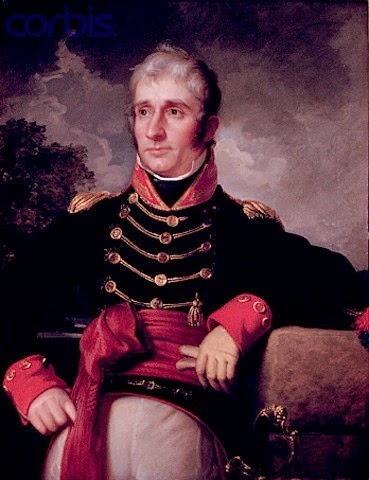 Rembrandt Peale: Lt. Col. Joseph Outen Bogart, c. 1822
Rembrandt Peale: Lt. Col. Joseph Outen Bogart, c. 1822Charles Willson Peale (1741-1826) sired a number of children named after famous artists, many of whom became well-known painters in their own right: Rembrandt Peale, Rapaelle Peale, Rubens Peale, and Angelica Kauffman Peale. Charles and several of his children studied with West in London. They became well known for portraits of early American leaders.
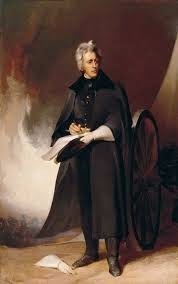 Thomas Sully ( 1783-1872): General Andrew Jackson, 1845
Thomas Sully ( 1783-1872): General Andrew Jackson, 1845Thomas Sully was born in England but came to the United States as a child of nine in 1792. He returned to London and studied under Benjamin West. Sully was celebrated enough to paint the young Queen Victoria in 1838. The version below is in New York's Metropolitan Museum. several other versions and copies are in the Royal Collection.,
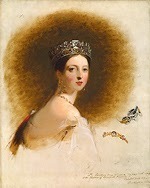 Sully: Queen Victoria
Sully: Queen VictoriaThe Corcoran's American Collection continues with many painters from the Hudson River School and other landscapes and portraits celebrating the beauties and dangers of the open spaces of the West.
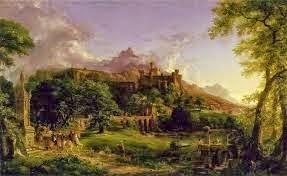 Thomas Cole (1801-1848) The Departure, 1837
Thomas Cole (1801-1848) The Departure, 1837Born in Lancashire, England, Cole came to Ohio as a boy and studied with itinerant painters. After moving to Philadelphia and developing as a painter, he studied the great masters in Europe. Cole is generally attributed with being the founder of the Hudson River School, that loosely based confederation of artists whose landscapes of the unspoiled American wilderness are treasured by museums across the country.
 Frederic Edwin Church (1826-1900), Niagra, 1857 Church was born in Connecticut to a wealthy family. He studied with Thomas Cole and became widely known and revered for his dramatic, romantic landscapes.
Frederic Edwin Church (1826-1900), Niagra, 1857 Church was born in Connecticut to a wealthy family. He studied with Thomas Cole and became widely known and revered for his dramatic, romantic landscapes.
Albert Bierstadt (1830-1902) Mount Corcoran 1877
Bierstadt was born in Prussia, and came to the U.S. in childhood. Though he returned to Germany to study art, he is best known for his romantic views of the American landscape as well as studies of the Westward Expansion. He traveled to the Pacific Coast, throughout California, Oregon and Washington.
 John Singer Sargent (1856-1925) The Oyster Gatherers at Cancale, 1878 Sargent was born to Amercan expatriate parents in Florence, Italy. He lived in Europe most of his life, studying in Paris and becoming a popular portrait painter in London. When he traveled to the US, he received many important commissions. But like so many successful portraitists, he preferred other subjects. Sargent traveled throughout Europe and to the Middle East, making watercolors sketches of his journeys.
John Singer Sargent (1856-1925) The Oyster Gatherers at Cancale, 1878 Sargent was born to Amercan expatriate parents in Florence, Italy. He lived in Europe most of his life, studying in Paris and becoming a popular portrait painter in London. When he traveled to the US, he received many important commissions. But like so many successful portraitists, he preferred other subjects. Sargent traveled throughout Europe and to the Middle East, making watercolors sketches of his journeys. 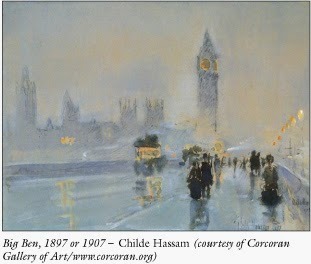 Childe Hassam, Big Ben, 1897-1907
Childe Hassam, Big Ben, 1897-1907Frederick Childe Hassam (1859-1935) was an influential American Impressionist, whose work helped to bring acceptance to the styles we now accept as so very familiar.
 Ellsworth Kelly (b. 1923) Yellow Red Triangle, 1973
Ellsworth Kelly (b. 1923) Yellow Red Triangle, 1973Ellsworth Kelly is one of many contemporary American artists whose works are in the collection of the Corcoran.
More ahead on the Corcoran Gallery of Art. All photos (except the first) ©Corcoran Gallery of Art
Published on April 09, 2014 00:30
No comments have been added yet.
Kristine Hughes's Blog
- Kristine Hughes's profile
- 6 followers
Kristine Hughes isn't a Goodreads Author
(yet),
but they
do have a blog,
so here are some recent posts imported from
their feed.



